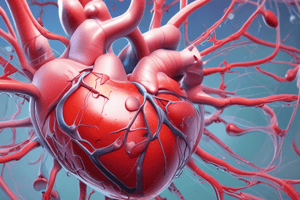Podcast
Questions and Answers
What is a characteristic of crystalloids?
What is a characteristic of crystalloids?
- They are solutions of electrolytes in plasma.
- They are indicated only for electrolyte replacement.
- They are classified by their overall tonicity after infusion. (correct)
- They are primarily used for blood clotting.
Why should administered fluids be considered as drugs according to the text?
Why should administered fluids be considered as drugs according to the text?
- To replace regular medications.
- Because they have no physiological effects.
- Due to their potential side effects. (correct)
- To minimize the need for rigorous analysis.
What distinguishes balanced solutions among crystalloids?
What distinguishes balanced solutions among crystalloids?
- They contain no electrolytes.
- They are primarily used for volume expansion.
- They include a buffer like lactate or acetate. (correct)
- They have a higher tonicity after infusion.
According to the passage, what percentage of an infused crystalloid solution remains in the intravascular compartment after 30 minutes?
According to the passage, what percentage of an infused crystalloid solution remains in the intravascular compartment after 30 minutes?
Which of the following statements is true regarding the distribution of crystalloids?
Which of the following statements is true regarding the distribution of crystalloids?
What is a potential consequence of large-volume crystalloid infusions?
What is a potential consequence of large-volume crystalloid infusions?
Which of the following statements is true regarding the distribution of colloids compared to crystalloids?
Which of the following statements is true regarding the distribution of colloids compared to crystalloids?
According to the passage, what is a factor that influences the intravascular volume-expanding effect of crystalloids?
According to the passage, what is a factor that influences the intravascular volume-expanding effect of crystalloids?
Which of the following statements is true regarding the distribution of crystalloid solutions in normovolemic subjects?
Which of the following statements is true regarding the distribution of crystalloid solutions in normovolemic subjects?
How does the osmolality of 0.9% NaCl compare to that of plasma?
How does the osmolality of 0.9% NaCl compare to that of plasma?
What happens to the ECF volume after a 2-L infusion of 0.9% NaCl?
What happens to the ECF volume after a 2-L infusion of 0.9% NaCl?
What effect does a 2-L infusion of 0.9% NaCl have on plasma albumin concentration?
What effect does a 2-L infusion of 0.9% NaCl have on plasma albumin concentration?
How does the Na+ and Cl− concentration of 0.9% saline compare to plasma?
How does the Na+ and Cl− concentration of 0.9% saline compare to plasma?
What is the effect of a 2-L infusion of 0.9% NaCl on hematocrit levels?
What is the effect of a 2-L infusion of 0.9% NaCl on hematocrit levels?
What is a potential side effect seen in healthy volunteers after receiving large-volume (50 mL/kg) saline infusions?
What is a potential side effect seen in healthy volunteers after receiving large-volume (50 mL/kg) saline infusions?
In which situation is 0.9% NaCl not suitable for treatment?
In which situation is 0.9% NaCl not suitable for treatment?
What clinical outcome is associated with the use of 0.9% NaCl in the wider critical care population compared to lower Cl− solutions?
What clinical outcome is associated with the use of 0.9% NaCl in the wider critical care population compared to lower Cl− solutions?
What is a possible use of hypertonic saline solutions mentioned in the passage?
What is a possible use of hypertonic saline solutions mentioned in the passage?
Why should the volume of saline administered perioperatively be limited according to the text?
Why should the volume of saline administered perioperatively be limited according to the text?
What distinguishes the effect of 0.9% NaCl from hypertonic saline with regard to intracranial pressure?
What distinguishes the effect of 0.9% NaCl from hypertonic saline with regard to intracranial pressure?
What was the key distinguishing feature of the early intravenous crystalloid solutions compared to NaCl solutions?
What was the key distinguishing feature of the early intravenous crystalloid solutions compared to NaCl solutions?
How do the osmolalities of currently available balanced crystalloid solutions compare to plasma?
How do the osmolalities of currently available balanced crystalloid solutions compare to plasma?
What is the primary mechanism by which the buffer in balanced crystalloid solutions helps restore bicarbonate levels?
What is the primary mechanism by which the buffer in balanced crystalloid solutions helps restore bicarbonate levels?
How do the Na+ and Cl- concentrations of balanced crystalloid solutions compare to 0.9% NaCl?
How do the Na+ and Cl- concentrations of balanced crystalloid solutions compare to 0.9% NaCl?
Why are dextrose solutions considered less suitable for intravascular plasma volume expansion?
Why are dextrose solutions considered less suitable for intravascular plasma volume expansion?
In what scenario would glucose solutions be coadministered with IV insulin to diabetic patients?
In what scenario would glucose solutions be coadministered with IV insulin to diabetic patients?
What is a potential consequence of using dextrose solutions in the postoperative period?
What is a potential consequence of using dextrose solutions in the postoperative period?
How do higher concentrations of dextrose serve as a metabolic substrate?
How do higher concentrations of dextrose serve as a metabolic substrate?
What makes glucose solutions less suitable for intravascular plasma volume expansion compared to other solutions?
What makes glucose solutions less suitable for intravascular plasma volume expansion compared to other solutions?
What is the main fate of acetate when it enters the body?
What is the main fate of acetate when it enters the body?
Why is the availability of crystalloids with HCO3 limited?
Why is the availability of crystalloids with HCO3 limited?
What can the transient decrease in plasma tonicity after infusion of balanced crystalloids lead to?
What can the transient decrease in plasma tonicity after infusion of balanced crystalloids lead to?
Why should lactated solutions be avoided in severe liver failure?
Why should lactated solutions be avoided in severe liver failure?
What potential negative effects have been identified with acetate-based dialysate?
What potential negative effects have been identified with acetate-based dialysate?
What are potential manifestations of high acetate levels in patients who receive dialysis with acetate-based fluids?
What are potential manifestations of high acetate levels in patients who receive dialysis with acetate-based fluids?
What is the primary characteristic of colloid particles according to the passage?
What is the primary characteristic of colloid particles according to the passage?
How do the molecular sizes of semisynthetic colloids differ from human albumin solution?
How do the molecular sizes of semisynthetic colloids differ from human albumin solution?
How do colloids differ from pure electrolyte solutions in terms of their effect on transcapillary filtration?
How do colloids differ from pure electrolyte solutions in terms of their effect on transcapillary filtration?
What is the initial volume of distribution for colloid molecules above 70 kDa?
What is the initial volume of distribution for colloid molecules above 70 kDa?
How do colloids differ from crystalloids in terms of their volume-expanding effect?
How do colloids differ from crystalloids in terms of their volume-expanding effect?
What is a potential limitation of the volume-expanding effect of colloids?
What is a potential limitation of the volume-expanding effect of colloids?
What is the primary mechanism by which colloid molecules can be lost from circulation?
What is the primary mechanism by which colloid molecules can be lost from circulation?
What is a potential adverse effect associated with the use of semisynthetic colloids in critical care?
What is a potential adverse effect associated with the use of semisynthetic colloids in critical care?
What is a characteristic of colloids that affects their intravascular retention time?
What is a characteristic of colloids that affects their intravascular retention time?
What is a potential benefit of colloid infusion mentioned in the passage?
What is a potential benefit of colloid infusion mentioned in the passage?
What is the primary mechanism by which gelatins are excreted from the body?
What is the primary mechanism by which gelatins are excreted from the body?
How do the molecular weights of succinylated gelatins and urea-linked gelatins (polygeline) compare?
How do the molecular weights of succinylated gelatins and urea-linked gelatins (polygeline) compare?
Which of the following is a potential negative effect associated with the use of gelatins?
Which of the following is a potential negative effect associated with the use of gelatins?
What is the primary component from which gelatins are derived?
What is the primary component from which gelatins are derived?
In terms of negative effects, which colloid have the least impact on hemostasis
In terms of negative effects, which colloid have the least impact on hemostasis
In terms of negative effects, which colloid have the highest estimated incidence of severe anaphylactic and anaphylactoid reactions
In terms of negative effects, which colloid have the highest estimated incidence of severe anaphylactic and anaphylactoid reactions
What is the primary determinant of Hydroxyethyl Starches (HES) elimination kinetics?
What is the primary determinant of Hydroxyethyl Starches (HES) elimination kinetics?
Which measure defines starches as hetastarches, hexastarches, pentastarches, or tetrastarches based on hydroxyethyl group presence?
Which measure defines starches as hetastarches, hexastarches, pentastarches, or tetrastarches based on hydroxyethyl group presence?
What does a higher C2/C6 hydroxyethylation ratio indicate about starch metabolism?
What does a higher C2/C6 hydroxyethylation ratio indicate about starch metabolism?
How is starch size classified based on in vitro MW?
How is starch size classified based on in vitro MW?
What is the primary factor responsible for both the therapeutic volume effects and adverse side effects of starch molecules?
What is the primary factor responsible for both the therapeutic volume effects and adverse side effects of starch molecules?
Which characteristic makes smaller HES molecules distinct after administration?
Which characteristic makes smaller HES molecules distinct after administration?
What role does the size of starch molecules play in pharmacokinetics and pharmacodynamics?
What role does the size of starch molecules play in pharmacokinetics and pharmacodynamics?
Why are smaller Hydroxyethyl Starch (HES) molecules distinct after administration?
Why are smaller Hydroxyethyl Starch (HES) molecules distinct after administration?
elimination of HES molecules
elimination of HES molecules
which of the following fluids have the longer plasma volume effects
which of the following fluids have the longer plasma volume effects
starch-related side effects?
starch-related side effects?
HES products affect coagulation
HES products affect coagulation
HES products affect coagulation through dilutional effects, which patients have the highest risk for bleeding?
HES products affect coagulation through dilutional effects, which patients have the highest risk for bleeding?
what is the mechanism of pruritic due to HES products
what is the mechanism of pruritic due to HES products
colloids are known to cause side effect such as severe anaphylactoid or anaphylactic reactions. what is the risk in HES products
colloids are known to cause side effect such as severe anaphylactoid or anaphylactic reactions. what is the risk in HES products
What is the primary concern associated with HES products of medium-to-high molecular weight in critically ill patients with preexisting renal impairment?
What is the primary concern associated with HES products of medium-to-high molecular weight in critically ill patients with preexisting renal impairment?
What is the primary mechanism of the antithrombotic effect of dextrans?
What is the primary mechanism of the antithrombotic effect of dextrans?
What percentage of a dextran dose is excreted renally within 24 hours?
What percentage of a dextran dose is excreted renally within 24 hours?
Which effect makes dextran 40 suitable for use in microvascular surgery according to the passage?
Which effect makes dextran 40 suitable for use in microvascular surgery according to the passage?
How are larger molecular weight dextrans primarily degraded in the body?
How are larger molecular weight dextrans primarily degraded in the body?
What is the duration of the plasma volume effect of dextrans?
What is the duration of the plasma volume effect of dextrans?
How dextran molecules can interfere with blood type cross- matching.
How dextran molecules can interfere with blood type cross- matching.
what is the risk for Anaphylactoid reactions with dextrans
what is the risk for Anaphylactoid reactions with dextrans
how we can reduce the Anaphylactoid reactions of the dextrans
how we can reduce the Anaphylactoid reactions of the dextrans
what is the mechanism of Renal dysfunction resulting from dextrans
what is the mechanism of Renal dysfunction resulting from dextrans
What is the theoretic risk for transmission of variant Creutzfeldt-Jakob disease and associated bovine spongiform encephalopathy despite preparation techniques in human plasma derivatives?
What is the theoretic risk for transmission of variant Creutzfeldt-Jakob disease and associated bovine spongiform encephalopathy despite preparation techniques in human plasma derivatives?
Why was the early concern that resuscitation with albumin could increase mortality in critical illness debunked?
Why was the early concern that resuscitation with albumin could increase mortality in critical illness debunked?
In what scenario might albumin be associated with an increased incidence of mortality, as mentioned in the text?
In what scenario might albumin be associated with an increased incidence of mortality, as mentioned in the text?
Why is the administration of exogenous albumin not proven to improve outcomes from critical illness according to the text?
Why is the administration of exogenous albumin not proven to improve outcomes from critical illness according to the text?
Which type of solutions, typically used for volume expansion, have a near-physiologic COP of 20 mm Hg?
Which type of solutions, typically used for volume expansion, have a near-physiologic COP of 20 mm Hg?
Flashcards are hidden until you start studying
Study Notes
Fluids in Perioperative Care
- Administered fluids should be considered as drugs with specific indications, cautions, and side effects.
- Many fluids available today were developed decades ago without rigorous analysis of their clinical benefits.
Crystalloids
- Crystalloids are solutions of electrolytes in water.
- Classified by their tonicity after infusion or overall composition.
- Examples: 0.9% Sodium Chloride, Balanced Crystalloid Solutions.
0.9% Sodium Chloride
- Not clear how it entered routine clinical practice.
- Has a Na+ and Cl− concentration far in excess of that of plasma.
- Osmolarity is slightly higher than that of plasma.
- Can cause hyperchloremic metabolic acidosis and reduced renal perfusion.
Balanced Crystalloid Solutions
- Have a lower overall osmolarity than 0.9% NaCl.
- Have a lower Na+ concentration and much lower Cl− concentration.
- Examples: Lactated Ringer solution, Hartmann's solution.
- Metabolism of lactate and gluconate leads to HCO3− production.
- Have a more rapid excretion of excess water and electrolyte load compared to 0.9% NaCl.
Hypertonic Saline
- Solutions of 1.8%, 3%, and 7.5% NaCl.
- Uses: plasma volume expansion, correction of hyponatremia, treatment of increased intracranial pressure.
- Can cause endothelial damage at high concentrations.
Dextrose Solutions
- Two main indications: as a source of free water and as a metabolic substrate.
- 5% dextrose is hypotonic with respect to the cell membrane.
- Can cause hyponatremia if used excessively.
Colloids
- Defined as large molecules or particles of a homogeneous noncrystalline substance.
- Examples: gelatins, dextrans, human plasma derivatives.
- Increase blood volume by hemodilution, reducing plasma viscosity and red cell aggregation.
- Have variable effective plasma half-lives due to filtration, renal filtration, and metabolism.
Gelatins
- Derived from bovine collagen.
- Modified by succinylation or urea-linkage.
- Have a similar molecular weight (MW) but different conformational changes.
- Rapidly leave the circulation, predominantly by renal filtration.
Dextrans
-
Highly branched polysaccharide molecules produced by bacteria.
-
Available dextrans have an average MW of 40 kDa or 70 kDa.
-
Rapidly filtered at the glomerulus, with 70% of a dextran dose excreted within 24 hours.
-
Have a plasma volume effect similar to that of starches, with a duration of 6 to 12 hours.### Human Plasma Derivatives
-
Human plasma derivatives include human albumin solutions, plasma protein fractions, fresh frozen plasma, and immunoglobulin solution.
-
These derivatives are relatively purified solutions with the elimination of infective agents.
-
There is a theoretic risk for transmission of variant Creutzfeldt-Jakob disease and associated bovine spongiform encephalopathy.
-
One U.K. case of presumed prion transmission has been described in association with factor VIII transfusion, without clinical manifestation.
Human Albumin Solutions
- 5% albumin solutions have a near-physiologic colloid osmotic pressure (COP) of 20 mm Hg.
- These solutions are used for volume expansion.
- Despite the association of hypoalbuminemia with worse outcomes from critical illness, the administration of exogenous albumin does not improve outcome in these situations.
- Early concerns that resuscitation with albumin may increase mortality in critical illness were not confirmed by a large controlled trial.
Hydroxyethyl Starches (HESs)
- HESs are modified natural polymers of amylopectin derived from maize or potato.
- The degree of substitution (DS) of hydroxyethyl radicals onto glucose units determines HES elimination kinetics.
- An alternative measure of substitution is the molar substitution (MS) ratio.
- HESs can be classified as hetastarches (MS 0.7), hexastarches (MS 0.6), pentastarches (MS 0.5), or tetrastarches (MS 0.4).
- The pattern of substitution may vary, and a higher C2/C6 hydroxyethylation ratio leads to slower starch metabolism.
- HESs are also classified by in vitro molecular weight (MW) into high (450-480 kDa), medium (200 kDa), and low (70 kDa).
Adverse Effects of HESs
- HES products with medium-to-high MW are associated with oliguria, increased creatinine, and acute kidney injury in critically ill patients with preexisting renal impairment.
- Even newer solutions with low MW (130 kDa/MS 0.4) have been shown to have similar effects on the need for renal replacement therapy in severe sepsis.
- The use of starch-based colloids has been restricted or suspended by regulatory authorities in both the United States and Europe.
Studying That Suits You
Use AI to generate personalized quizzes and flashcards to suit your learning preferences.




